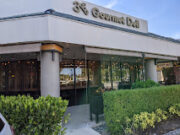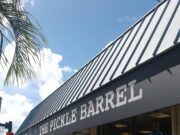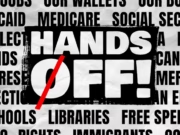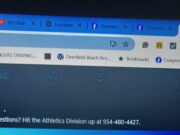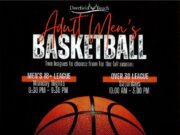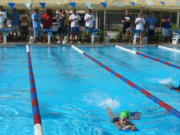
Deerfield-News.com-Deerfield Beach, Fl-From BSO they have not heard of the tip of putting in your PIN in reverse. I have contacted Wells Fargo and have asked for someone in security to get back with us as we are doing a story about the subject of being robbed at the ATM. I did find the following from www.gobankingrates.com which dispels the reverse PIN number as a rumor. www.Snopes.com also dispels this as being false
#1. Enter ATM PIN Number Backwards as Distress Call
If being robbed at the ATM, typing your PIN number backwards automatically calls the police.
Fact: Perhaps out of seeking a false sense of security, a rumor began circulating in the mid 2000s: in the event you’re being robbed at the ATM for your money, entering your PIN number in reverse discreetly alerts the authorities. But like the idea of a 911 call that goes unanswered, doing this at the ATM not only doesn’t work, it can be dangerous.
A Chicago-area attorney named Joseph Zingher is said to have invented an ATM PIN number reversal system, but so far, has been unsuccessful in convincing lawmakers and banks to implement the technology in ATMs. Part of the reason, according to several sources, is the logistics: accidentally typing in your ATM PIN number backwards could trigger too many false alarms. It could make an unsafe scenario even riskier, say banks; few customers being held up at gunpoint are likely to remember their PIN in reverse, or worse yet, in stalling to do so, could anger an armed gunman.
However, the word “seemingly” applies in this case because the tip is only a chimera, as entering one’s Personal Identification Number (PIN) in reverse at Automated Teller Machines (ATMs) does not automatically summon the police.
The Credit Card Accountability Responsibility and Disclosure Act of 2009 compelled the Federal Trade Commission to provide an analysis of any technology, either then currently available or under development, which would allow a distressed ATM user to send an electronic alert to a law enforcement agency. The following statements were made in the FTC’s April 2010 report in response to that requirement:
FTC staff learned that emergency-PIN technologies have never been deployed at any ATMs.
The respondent banks reported that none of their ATMs currently have installed, or have ever had installed, an emergency-PIN system of any sort. The ATM manufacturer Diebold confirms that, to its knowledge, no ATMs have or have had an emergency-PIN system.
Ergo, there aren’t and haven’t ever been “reverse PIN” technologies despite online claims dating to September 2006 that anyone being robbed at an ATM simply had to enter his or her PIN in reverse to summon help.
Moreover, said that FTC report:
The available information suggests that emergency-PIN and alarm button devices: (1) may not halt or deter crimes to any significant extent; (2) may in some instances increase the danger to customers who are targeted by offenders and also lead to some false alarms (although the exact magnitude of these potential effects cannot be determined); and (3) may impose substantial implementation costs, although no formally derived cost estimates of implementing these technologies are currently available.
The reverse PIN system was first imagined in 1994 and patented in 1998 by Joseph Zingher, a Chicago businessman. His SafetyPIN System would alert police that a crime was in progress when a cardholder at an ATM keyed in the reverse of his personal identification numbers. The flip-flopped PIN would serve as a “panic code” that sent a silent alarm to police to notify them that an ATM customer was acting under duress. Because palindromic PINs (e.g., 2002, 7337, 4884) cannot be reversed, Zingher’s system included work-arounds for such numeric combinations.
However, Zingher had little success in interesting the banking community in SafetyPIN despite his pitching it to them with great persistence over the years. He did in 2004 succeed in getting the Illinois General Assembly to adopt a “reverse PIN” clause in SB 562, but the final version of the bill watered down the wording so as to make banks’ implementation of the system optional rather than mandatory: “A terminal operated in this State may be designed and programmed so that when a consumer enters his or her personal identification number in reverse order, the terminal automatically sends an alarm to the local law enforcement agency having jurisdiction over the terminal location.”
In 2006, Michael Boyd pressed the Georgia State Assembly to pass a law requiring banks to create ATM panic codes that would operate the machines normally while also alerting police. His wife, Kimberly Boyd, was killed on 12 September 2005 after being carjacked by convicted sex offender Brian O’Neil Clark and forced to withdraw cash at an ATM. (She died when Clark crashed her SUV while being followed by a civilian who ultimately shot Clark to death afterwards.) Such a bill was placed before the Georgia Senate on 29 December 2005 (SB 379), but nothing came of it.
In 2004, the Kansas state Senate sent to its Financial Institutions and Insurance Committee SB 333, a bill that stated: “Any automated teller machine operated in this state shall be designed and programmed so that when a consumer enters such consumer’s personal identification number in reverse order, the automated teller machine automatically sends an alarm to the local law enforcement agency having jurisdiction over the automated teller machine location.” That bill died in committee that year.
All this talk of various bills in three different state legislatures may serve to obscure some of the more important points attaching to this issue, points that are key to making up one’s mind about whether having such a system in place is actually a good idea.
No one in the banking industry seems to want the technology. The banks argue against its implementation, not only on the basis of cost but also because they doubt such an alert would help anyone being coerced into making an ATM withdrawal. Even if police could be summoned via the keying of a special “alert” or “panic” code, they say, law enforcement would likely arrive long after victim and captor had departed. They have also warned of the very real possibility that victims’ fumbling around while trying to trigger silent alarms could cause their captors to realize something was up and take those realizations out on their captives.
Finally, there is the problem of ATM customers’ quickly conjuring up their accustomed PINs in reverse: Even in situations lacking added stress, mentally reconstructing one’s PIN backwards is a difficult task for many people. Add to that difficulty the terror of being in the possession of a violent and armed person, and precious few victims might be able to come up with reversed PINs seamlessly enough to fool their captors into believing that everything was proceeding according to plan. As Chuck Stones of the Kansas Bankers Association said in 2004: “I’m not sure anyone here could remember their PIN numbers backward with a gun to their head.”
www.Snopes.com-
CLAIM
Entering your PIN in reverse at any ATM will automatically summon the police.
RATING
 FALSE
FALSEORIGIN
Messages offering a seemingly helpful heads-up about how to deal with a situation in which one is forced to hand over money withdrawn from an ATM under duress began circulating on the Internet in September 2006:
The Credit Card Accountability Responsibility and Disclosure Act of 2009 compelled the Federal Trade Commission to provide an analysis of any technology, either then currently available or under development, which would allow a distressed ATM user to send an electronic alert to a law enforcement agency. The following statements were made in the FTC’s April 2010 report in response to that requirement:
FTC staff learned that emergency-PIN technologies have never been deployed at any ATMs.
The respondent banks reported that none of their ATMs currently have installed, or have ever had installed, an emergency-PIN system of any sort. The ATM manufacturer Diebold confirms that, to its knowledge, no ATMs have or have had an emergency-PIN system.
The best tips I could find pending responses if we receive them from Wells Fargo are the following from www.INC.com.-
Secure Your ATM/Debit Card and PIN
- If you keep your ATM card (or debit-enabled ATM card) in your wallet, make sure that you protect your wallet. Do not leave it lying around where someone can take out the ATM card. This includes at work and in restaurants. Magnetic strip ATM cards can be copied in seconds. (All of this is also true for credit cards.)
- Consider asking your bank for an ATM card that cannot be used as a debit card. While such cards may lack the ability to be used to buy goods and services, if you make your purchases using a credit card, you do not need that convenience. By preventing the card from being used as a debit card you make it more likely that only someone who knows your PIN number can take money out of your account.
- Choose a random Personal Identification Number (PIN) unrelated to any information that you know. Do not use a PIN that you have used for some other purpose, and do not establish any other PINs or passwords based on the one you chose for your ATM card. Never write down your PIN. Never add it to any computer file. Never tell anyone your PIN – and “anyone” includes bank employees.
- Immediately notify your bank if your ATM card is lost or stolen.
Safely Choose and Approach ATMs
- Try to use ATM machines during daylight, as most ATM robberies occur at night. In fact, statistically speaking, you are many times more likely to get robbed at an ATM at night than during the day. If you must go at night, do not use an ATM if there is not plenty of light around it. You want people to be able to easily see you when you are there.
- Likewise, avoid, at all hours, ATMs that cannot be seen from the street or from other public places (e.g., inside busy stores is fine) – criminals love ATMs obscured by trees or bushes and those located behind buildings; thieves want as few witnesses to their crimes as possible. I don’t know why anyone installs ATMs in hard-to-see locations, but there are plenty of such machines.
- Going to an ATM with another person can dramatically improve your odds of avoiding being robbed. It is not always practical to do so, but, especially if you cannot avoid other risk factors – e.g., you must go to an ATM at night – consider going with at least one more person. Robbers prefer to target people who are alone.
- If anything seems amiss when you approach the ATM, don’t approach it. Notice suspicious people, objects, cars, etc. If someone is loitering near the ATM, don’t approach it; robbers often “hang out” nearby waiting for would-be victims. If your gut says a situation may be unsafe, avoid it.
- Ideally, go to an ATM inside a bank during bank hours. After hours, if you can go to an ATM inside a store that has staff working, choose that ATM over those in deserted bank lobbies. A small service fee may be worth the added security, and some stores have ATMs with no service fees (e.g., 7-11 ATMs for Citibank customers).
- Minimize the time that you are at the ATM. Have your ATM card ready and in your hand as you approach the ATM, and know your PIN number so you can enter it quickly; do not wait until you are in front of the ATM to take your card out of your wallet or purse, and never look up your PIN number in a smartphone while at the ATM. If your ATM card has a chip, make sure it is clean before going to the ATM. (You can use a tiny amount of hand sanitizer to clean it.) If you are making a deposit, prepare the checks and cash before you go to the ATM.
- When using a drive-through ATM, keep your car running, with all windows and sunroofs fully closed except for the driver’s window. If you are in a convertible, close the roof. Watch your rearview and side mirrors – robbers intending to rob someone in a car often approach from the back of the vehicle in order to leverage the element of surprise, and they typically approach on the driver’s side. There are some experts who recommend keeping your car in Drive and your foot on the brake when using drive-through ATMs, as doing so will allow you to escape the area quickly if you see danger approaching; following such advice, however, may increase the risk of a car accident more than it improves your odds of not being robbed, and, as such, I recommend keeping the car in Park unless you are absolutely sure that you will not accidentally let the car move if it is in Drive while you are at ATM. Keep in mind that the risk of keeping the car in Drive is likely greater for right-handed people who often turn their bodies in order to use the ATM through the driver’s window with their right hands.
- If you drive to a walk-up ATM, lock all doors to your car and close all windows and sunroofs fully when you park, before approaching the ATM.
When Using an ATM
- Visually look over the ATM before inserting your card – look for cameras and skimming devices (skimming devices are devices that read your ATM card and are often inserts added over the original ATM card slot), or signs of tampering. Some clues that an ATM might have been tampered with include physically misaligned or crooked sections of the machine, damage to the machine such as dents, scratches, or broken pieces, any loose components, sticky residue, anything atypical near the card slot or keypad, visible holes in the machine, anything stuck to the machine or the surrounding area (including to the wall behind you when you stand at the ATM), or, if the ATM has a physical keypad, any abnormal resistance when pressing keys.
- Do not let anyone see any of the activity that you perform on the ATM – especially not your PIN when you enter it. Block the ATM screen with your body, and, whether the ATM has a physical keypad or on-screen keypad, use one hand to enter the PIN and the other to cover the area. Theoretically, it might be best to enter part of your PIN with one hand and part with the other – but I suspect that such advice would be deemed by most people to be impractical, and, therefore, would be rarely followed. Also, keep in mind that all around us there are high-resolution cameras with zoom capabilities – do not rely on the fact that you cannot see someone looking: always block views of the ATM and keypad.
- On that note, if there is a line of people waiting for the ATM, or, if, for any other reason, someone is behind you when you approach the ATM, ask that person to step back until he or she is at a comfortable distance. If he or she does not comply, either call security, leave, or let the offender use the ATM first.
- Be in possession of cash for as little time as possible at the ATM. While some robbers will force people at gunpoint to make withdrawals, others just take cash that a victim already holds. If you need to withdraw money and perform other tasks (e.g., checking balances, making payments), always withdraw the money last. If you need to make a deposit that includes cash, make it first.
- If possible, do not withdraw large amounts of cash in a single ATM visit. If you must get large amounts, it is better to try to break the withdrawals into two or three separate trips to ATMs (don’t break the withdrawals into too many trips or the bank may prevent the withdrawals).
- When you withdraw money, immediately put it into your wallet, purse, or pocket. Contrary to the oft-repeated conventional advice, with rare exceptions you should not count the money you receive from an ATM while you are at the ATM. The odds of the ATM making a mistake are miniscule compared with the increased risk of robbery that you can create by counting cash in a public, often targeted location. If you count the money when you come home and discover that a mistake was made, you can explain to your bank why there was a short delay in reporting it – the folks there are aware of the security risks at ATMs.
- Either do not request a receipt, request that it be emailed to you (if your ATM offers such a feature), or take it with you. Never leave ATM receipts behind.
- If somehow you are robbed, do not argue or fight with a robber. Give him or her your cash – do not risk your life over money. But, while you may be in a state of shock, stay calm and try to memorize as much about the perpetrator as you can. The better that you can describe the thief to police – and provide information about his or her escape vehicle and direction of exit – the better the chances are that he or she will get caught. Call the police as soon as the robber leaves. If the robber tells you to leave, leave, and call police after you arrive at a safe location.
Most banks not only have cameras in the ATM machines but above them and in other spots which may not be visible to the public.
Thanks for the story idea Katy.









